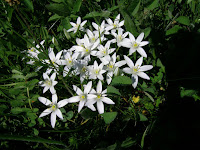Silver Bells Bulb Planting - ornithogalum umbellatum
 |
| Ornithogalum angustifolium |
 |
| Ornithogalum nutans & umbellatum side by side |
As usual, part of the problem is the lack of in-depth research. Ornithogalum nutans is from Asia and can become invasive. Ornithogalum umbellatum, from Europe, does not. Both are called Star of Bethlehem, Dove's Dung and Silver Bells so check to be sure you plant the one that suits your needs.

I ordered O. umbellatum from Old House Gardens Bulbs and planted them in a little spot that has not been cultivated before. The bed is opposite the vegetable garden though so we are over there quite a bit from early spring cultivating through January when we are harvesting Russian kale for the table.
Native to Europe, from the Mediterranean to Britain, O. umbellatum leaves are grass-like and the eventing blooming flowers are white-cream and green. They are deer and rodent resistant.
The bulbs are planted 4-6 inches deep and apart. They like ground that is on the dry side or gravelly so don't mulch them.

Although heavy rains wash my plant tags to nearby locations during good rain years, I always mark them anyway. We use old mini-blinds (Tip from Sharon Owen, Moonshadow Herb Farm) that are easily cut with scissors and print adhesive labels with a $10 Brother label maker (Tip from Jerry Gustafson).



Comments